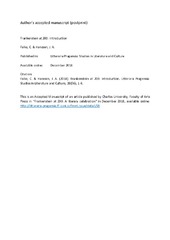Frankenstein at 200: Introduction
Permanent lenke
https://hdl.handle.net/10037/31087Dato
2018Type
Journal articleTidsskriftartikkel
Peer reviewed
Sammendrag
Derek Attridge says of James Joyce that one can never be a first-time reader of that authors work.1 The same can be said of Mary Shelley, particularly with regard to her first novel, Frankenstein: Or The Modern Prometheus. There cannot be many readers who come to it without prior ideas of what to expect. Images of the creature pervade popular culture, and most English readers know Victors tale of overweening ambition even if they have not read the novel. The FrankensteinmythasChris Baldick has called it, outstrips the novel itself and reaches readers first.2 John Wilson Croker was confident, in 1818, that readers wouldwonderandshudderatthetaleandquestionafterastrugglebetween laughterandloathingwhether the head or the heart of the author be the mostdiseased3 In 2018, we are less convinced of what a novel should be, and therefore more appreciative of what Shelley shows it can be, but as todays readers we have to remind ourselves how daring her subject matter; her direct, impassioned language; and her innovations in narrative form really were.
Beskrivelse
Author's accepted version (postprint).
This is an Accepted Manuscript of an article published by Charles University, Faculty of Arts Press in "Frankenstein at 200: A literary celebration" in December 2018.
Available online: http://litteraria-pragensia.ff.cuni.cz/front.issue/detail/58.
Forlag
Charles University, Faculty of Arts PressSitering
Falke C, Hanssen JHA. Frankenstein at 200: Introduction. Litteraria Pragensia: Studies in Literature and Culture. 2018;28(56):1-6Metadata
Vis full innførselSamlinger
Copyright 2018 The Author(s)


 English
English norsk
norsk